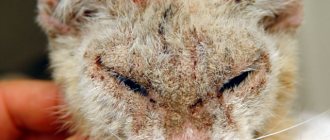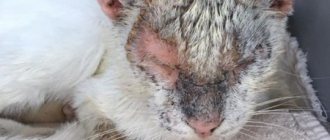What will you learn from the article?
- The causative agent of demodicosis in cats is the subcutaneous mite. Routes of infection
- Risk group
- Diagnostics
- Treatment of localized form
Demodectic mange in cats is a parasitic disease that affects the skin and hair of animals. The cause of this disease is the subcutaneous demodex mite. In our article we will tell you which ectoparasites cause pathology, what are the first symptoms of infection, what forms of the disease exist, and how it is treated.
Features of the subcutaneous mite
In cats, demodicosis is often diagnosed. The causative agent of this dermatological disease is the demodex subcutaneous mite. The insect belongs to the arthropod family; there are two types of parasites: gatoi and cati.
Mites reproduce in the glands that produce saliva, sweat and in the roots of hairs. The female lays oocytes, from which larvae appear after 4-6 days. In order to turn into adults capable of reproduction, they need from 7 to 10 days. Microorganisms form colonies, which can be identified by small bumps on the animal's skin. Large accumulations of mites lead to dysfunction of the skin and atrophy of the sebaceous glands.
Demodicosis can be localized or generalized. In the localized form, individual areas are affected: the neck and chin, eyes, ears. Generalized demodicosis spreads throughout the body. The risk group for this type of disease includes representatives of the Burmese and Siamese breeds.
Content
1. Routes of infection 2. Signs and symptoms of damage 3. Diagnosis 4. Localized demodicosis 5. Generalized demodicosis 6. Folk remedies 7. Pregnant cats and kittens 8. Preventive measures 9. Possible complications
Pets, including cats, are susceptible to developing many diseases. Their body is vulnerable to the effects of endoparasitic mites. This insect is the main causative agent of demodicosis, a dangerous disease for four-legged pets. In most cases, ticks in cats appear as a result of direct contact with an already infected pet or stray animal.
A subcutaneous tick in a cat can be identified by its gray oval body. The causative agent of infection is represented by a microscopic organism. It settles on the body of a four-legged pet and begins intensive reproduction. The parasite lays its eggs in the hair follicles of the unfortunate cat. After a short time from the moment of infection, the cat begins to develop visible symptoms of illness. If you find them, immediately take your pet to an experienced veterinarian.
Causes of the disease
Subcutaneous mites can live in a cat’s body for many years. The natural defense system restrains its reproduction, the disease does not manifest itself in any way. The tick feeds on dead cells of the epithelial layer. When a cat’s body is weakened, immunity is reduced, microorganisms begin to multiply quickly, and demodicosis appears. The reasons for this phenomenon may be:
- chronic diseases;
- worms;
- non-compliance with care rules;
- poor quality nutrition that does not provide the supply of necessary minerals and vitamins;
- lack of preventive antiparasitic measures.
Stress can also weaken an animal’s natural defense system.
Diagnostics
Subcutaneous ticks in cats can carry several types of infection. In each specific case, to make an accurate diagnosis, the veterinarian takes several scrapings from the affected areas of the endometrium from the animal. The collected material is examined under a microscope.
Demodicosis comes in two forms
- local;
- generalized.
In the first case, the lesion most often affects kittens. The lesion affects one part of the pet's body. Early signs of infection appear in the nose, eyes, lips and ears.
Generalized mites in cats provoke more serious health problems, since the lesion simultaneously affects several areas of the body. In the case of generalized demodicosis, the cat is sterilized after recovery. This is due to the high probability of inheritance of the disease.
The veterinarian selects an individual therapy program for each affected animal. The specialist is guided by the identified form of illness and the actual condition of the cat.
Methods of infection with subcutaneous mites
There are several ways of infection with an arthropod parasite:
- transmission of the parasite through direct contact with a carrier;
- indirect contact with the belongings of an infected individual, subcutaneous ticks can get onto a cat from the bedding of an animal that has these diseases, or from a hair brush. A person can carry these microorganisms on clothing if he has had contact with an infected animal.
- intrauterine infection.
Owners of several cats and breeders need to simultaneously treat all pets when the disease is detected.
Feline mange (notohedral mange)
Notoedres cati mite infestation is a rare and highly contagious skin disease of healthy cats. For the development of the disease, just one individual is enough. The insect is transmitted through contact through blankets, clothing or care items, from a sick mother to kittens during feeding, through human hands during stroking or any touch.
Contagious to cats, dogs and people who come into contact with it.
Symptoms
- constant itching;
- scalp lesions;
- lesions of the limbs, perineum;
- papules, crusts;
- weakness, lethargy;
- alopecia of the affected areas;
Pets at risk
No cat breed is immune from demodicosis. Infection with arthropod parasites is not dangerous for a healthy animal. Strong immunity will prevent it from reproducing. However, those at risk include:
- kittens separated from a cat early;
- pets after surgery;
- cats exhausted by prolonged starvation;
- animals with various diseases: rickets, toxoplasmosis, diabetes, leukemia, etc.
The development of the disease can be triggered by stress associated with a change of place of residence or constant visits to the pet groomer.
Is it possible to get infected from a person?
The Demodex mite affects not only animals, but also people. However, these are completely different types of parasite. As has already become clear, infection from an animal is not dangerous. But transmission from person to person is possible.
Routes of infection from humans:
- direct contact;
- cloth;
- bed sheets;
- facial cleansing in the salon.
According to statistics, 90-92% of the population are carriers of the subcutaneous mite. But demodicosis manifests its symptoms only in certain cases: weakened immunity, frequent stress, pregnancy, metabolic disorders.
An exacerbation of the disease is often observed in the autumn season. The reason for this is the experience of hot summer days, when the skin often sweats and becomes oilier. In addition, summer heat, or rather ultraviolet radiation, can significantly weaken the immune system.
Symptoms of the disease
The rapid growth of subcutaneous mite colonies causes itching in the animal. Active hair loss is observed, and bald patches with an oval outline are formed. In these areas, the skin becomes reddish and ulcers appear. Infectious abnormalities appear as secondary signs. In most cases, subcutaneous mites are localized on the front legs, near the eyes, on the neck, and chin.
The main signs of demodicosis are:
- hair loss;
- swelling, redness of the skin;
- ulcers and pustules;
- decreased appetite;
- weight loss;
- severe itching;
- unpleasant odor;
- unkempt look.
The generalized form, developing, can lead to blood poisoning.
Signs and symptoms of the lesion
The main areas of dislocation of the subcutaneous mite are considered to be the muzzle and the front part of the body of the pet. The parasite can live on the body of a new victim for quite a long time without symptoms. The first signs of damage will appear when the pet’s immunity decreases.
At this point, the owners begin to note:
- deterioration of the exterior;
- the appearance of keratinization areas in the eye area;
- impaired skin pigmentation;
- the appearance of dandruff over the entire area covered with hair;
- hair loss in clumps.
Sometimes pets develop acne and severe itching occurs in certain areas of the skin. The cat begins to scratch constantly, which leads to the formation of a blood crust. The height of the crust covering the wound can reach 12 mm. At the top of the growth there remains a small hole from which a stream of ichor continuously oozes. Areas of the skin with alopecia become covered with small ulcers, and the skin acquires a silvery tint.
The symptoms listed above occur because under the skin of a pet the tick digs passages along which it constantly moves. The products of its vital activity remain here. To examine the subcutaneous tick on the body of a four-legged pet, you do not need to make superhuman efforts. If you take a bald area of skin and make a fold out of it, you will even be able to remove the parasite yourself.
After examining the insect, it should be placed in an airtight container and transported to the veterinary clinic along with the injured cat. A specialist will be able to conduct a thorough diagnosis and outline an algorithm for the owner’s subsequent actions, which will help return the animal to a full life.
Treatment of demodicosis
The cat can recover on its own, without therapeutic treatment. But this is only possible with a localized form of the disease, if the pet’s body is strong and has a strong defense system. In any case, if signs of illness are detected, it is necessary to contact a veterinary hospital.
When treating demodicosis in an uncomplicated form, local therapy is used. Can be used:
- Shampoos containing antiseptic components to remove dead epithelial cells and waste products of microorganisms.
- Mitaban solution for treating affected areas. For the treatment of localized demodicosis, a composition with a concentration of 0.25% is used. For a generalized disease without complications, a solution containing 0.5% of the active component is used. If staphylocosis or pyodemocosis has developed against the background of demodicosis, you need a product with a concentration of 1%.
- Advocate drops are used in treatment and prevention. The product is applied with a pipette to places inaccessible to the cat.
- Preparations containing amitraz, pyrethrin for treating affected areas.
- Demodex gel, Saphroderm and sulfuric ointments to eliminate foci of inflammation.
Only a veterinarian should select products, dosages, and regimens of use. Exceeding concentrations can cause harm to the cat’s body.
Medicines and injections
If this is your first time encountering this problem, it will be quite difficult for you to choose a remedy for subcutaneous mites in cats on your own. Since the disease is divided into two forms (depending on the size of the affected skin), localized and generalized. Medicines are prescribed after examination by a veterinarian.
Localized form
This form of the disease is characterized by small skin lesions. Choosing a remedy for subcutaneous mites in cats for this form is not difficult, since there is a large selection of ointments, sprays, and shampoos. The treatment is simple, the main thing is to start on time and follow the correct sequence. Remember, the drug is applied only after cleansing the skin.
Medicines for localized form:
- Sulfuric ointment;
- Aversectin ointment;
- Unoiled;
- Tsidem;
- Demos liniment;
- Amit;
- Ivermek-gel.
In addition, the animal will need a drug that will increase immunity. This could be Gamavit, Immunoparasitan, Gala-vet or Maxidin.
Generalized form
This form of demodicosis is more difficult to treat, since almost all of the animal’s skin is affected. You shouldn’t give up, even if your pet already has ulcers and severe irritation – you can cure your cat.
In order for the drug for external use to be well absorbed, it is recommended to cut the animal’s hair and bathe it with medicated shampoo. After soaking the skin with special medicinal oils and after drying, treat the affected areas with the prescribed drug. In more severe cases, injections will be needed.
Preparations for injection:
- Cydectin - single dose - 0.4 ml;
- Dectomax - the dose is calculated by the veterinarian depending on the weight of the cat.
If the disease occurs with complications, this means that a secondary infection has joined demodicosis. In this case, the doctor will prescribe antibiotic injections.
Antibiotics for complicated forms of demodicosis:
- Betamox;
- Amosin;
- Amoxicillin;
- Kanamycin;
- Baytril.
In case of a complicated form, it is important to balance your pet’s diet. Include foods fortified with minerals and vitamins. This can be boiled porridge with fish or meat, with the obligatory addition of vegetables.
Complex treatment of complex forms
If generalized demodicosis or a localized form with complications is diagnosed, then complex therapy is required, including:
- applying Amitraz oil solution;
- oral administration of Doramectin;
- distribution of Ivermec spray on the affected areas;
- parenteral administration of antiparasitic drugs;
- use of antibacterial agents.
At the same time, it is necessary to strengthen the cat’s immunity, for which the biogenic preparations Baksin and Gamavit are used.
Treatment with folk remedies
In addition to medications prescribed by a doctor, you can use folk remedies to increase the effectiveness of treatment. Treatment of affected areas and wounds can be carried out:
- Ready-made tincture of calendula flowers, purchased at a pharmacy.
- A tincture prepared from the dry herb of tanning mackerel. A spoon of the product is filled with 500 ml of boiling water. After cooling, strain, dilute with 500 ml of cat bathing water.
- Concentrated decoction of chamomile.
Kerosene cannot be used for processing. It causes severe intoxication.
How and how to treat demodicosis in dogs and cats
In the treatment of this disease it is necessary to use acaricidal agents, antiseptics and antibiotics. Additionally, anti-inflammatory drugs, tissue regeneration activators and immunostimulants can be used.
The Ivermek line of drugs from the NITA-FARM company can help with demodicosis. So, Ivermec spray is a combination product that contains:
- ivermectin - has a pronounced antiparasitic effect;
- lidocaine - reduces pain and itching;
- dexpanthenol - promotes tissue healing;
- chlorhexidine - fights concomitant infections.
Treatment of demodicosis in dogs and cats with this drug consists of treating the affected areas 2-4 times with an interval of 3-5 days until clinical symptoms disappear.
More detailed information about the drugs in the Ivermek line and other NITA-FARM veterinary drugs can be found in the product catalog
Disinfection of veterinary inspection facilities Cattle diseases
Preventive measures
The main prevention of this disease is to maintain a strong immune system in a cat with a complete, balanced diet and proper care. It is also necessary:
- treat the tray, bedding, and bowls with disinfectants every week;
- regularly use sprays and tablets with antiparasitic properties;
- Put your pet on a collar treated with anti-parasite agents.
If a cat has suffered from generalized demodicosis, it must be sterilized.
Pregnant cats and kittens
Pregnant cats and kittens are considered to be at increased risk of contracting an unwanted infection. Therapy, in this case, is implemented with certain difficulties. If a tick is found in cats during pregnancy, then local drugs that are not absorbed into the body are chosen for treatment. Most often, these drugs are produced on an oily basis. Any treatment with similar means is preceded by cleaning the surface of the pet’s skin and removing scabs.
There are similar recommendations for kittens. It is important to seek help from a professional veterinarian as early as possible. Only he can correctly select the safest treatment.











